Abstract
As the leading grain-producing region in China, Heilongjiang Province is crucial to the country’s food security. Thus, determining Heilongjiang’s agricultural carbon emissions status and trend projections provides a baseline for supporting low-carbon emission reduction in this sector. This study analyzes carbon emissions from crop farming and farmland soil in Heilongjiang from 2003 to 2022, focusing on two carbon sources: agricultural land use and soil. BP neural network model, emission factor coefficient approach, Tapio decoupling framework, and LMDI model are used. These findings show that Heilongjiang’s planting industry carbon emissions initially increased and then decreased, with chemical fertilizers and rice being the main sources. Harbin, Qiqihar, Jiamusi, and Suihua contribute significantly to soil carbon emissions from farming. In “weak decoupling-expanding negative decoupling-strong decoupling,” economic levels drive carbon emissions, while production efficiency is the key countermeasure. Qiqihar will not peak between 2023 and 2030, while the other 12 Heilongjiang cities will. Therefore, these emission-reduction proposals are presented: Restructuring (increasing drought-resistant and cold-climate low-carbon crops), optimizing fertilization (soil testing and organic fertilizers), and improving resource utilization can help Heilongjiang Province achieve “food security, ecological preservation, and low-carbon development” in its agricultural practices.
1. Introduction
Carbon emissions represent a key driver of climate change. The “Climate Change 2023” study by the United Nations Intergovernmental Panel on Climate Change (IPCC) predicts that global temperatures will reach the 1.5 °C threshold between 2030 and 2035. Under unchanged policies, global warming could exceed 3.2 °C by 2100. Climate warming increases soil GHG emissions, potentially exacerbating climate change through positive feedback mechanisms [1]. Global greenhouse gas emissions continue to rise at an unprecedented rate. The trend of global warming exhibits no signs of abatement. Consequently, the adoption of emission reductions to alleviate global climate warming has reached a general consensus within the worldwide community.
Agriculture serves as a substantial source of greenhouse gas emissions globally. As a leading agricultural nation, China plays a pivotal role in influencing worldwide agricultural carbon emissions. In the Chinese context, agricultural carbon emissions represent 17% of total greenhouse gas emissions, with the planting industry responsible for 16% of overall agricultural carbon emissions [2,3]. As a prominent global leader in agricultural growth, China has significantly advanced in reducing agricultural carbon emissions since the early 21st century. Nonetheless, agricultural development faces numerous urgent challenges. These pressing concerns highlight the immediate necessity for a transition from traditional high-carbon farming systems to sustainable low-carbon alternatives. The increasing demand for high-yield and high-quality food crops has led to the excessive use of agricultural inputs like fertilizers and pesticides, altering agroecosystems and intensifying agricultural carbon emissions. Furthermore, intensive and frequent tillage practices markedly diminish the soil’s carbon sequestration potential [4] and concurrently increase carbon emissions from the soil. When the ability of soil to sequester carbon exceeds its emission level, it plays a pivotal role in mitigating greenhouse gas emissions.
China’s current carbon reduction targets are driven by both the imperatives of domestic development and China’s global responsibilities as a major power. In response to and consistent with a series of national policies and directives on emission reduction, Heilongjiang Province has implemented a comprehensive set of measures to reduce emissions [5,6]. Consequently, regulating anthropogenic activities and optimizing agricultural land use are critical for China to achieve its dual goals of carbon peaking and carbon neutrality while mitigating environmental challenges.
In recent years, extensive research efforts have focused on greenhouse gas emissions from the planting industry at both the national and the global scales, examining areas such as carbon emission accounting methodologies and spatiotemporal dynamics [7,8], comprehensive analysis of driving factors [9,10], longitudinal trends in carbon emission evolution [11,12], and methodological applications of the Tapio decoupling model [13,14]. The scope of agricultural carbon emission accounting can be broadly divided into two primary dimensions: the input perspective, encompassing agricultural material inputs and land utilization practices [15,16,17], and the second dimension, which focuses on the production process, encompassing land utilization practices, methane (CH4) emissions from rice paddies, and nitrous oxide (N2O) emissions from agricultural fields [18]. He et al. [19] conducted an analysis of carbon emissions in the planting industry, focusing on rice cultivation and the utilization of agricultural inputs. Their findings highlighted that N2O emissions from farmland constitute the predominant component of the overall carbon emission profile. In a related study, Chao et al. [20] assessed carbon emissions from agricultural production processes by investigating the production and application of agricultural materials. Their results identified tillage, fertilizer use, irrigation, and the operation of agricultural machinery as the principal contributors to carbon emissions.
Within the framework of carbon emission accounting, Hefler et al. [21] analyzed materials, energy inputs, and related emissions along the grape wine life cycle; Cai et al. [22] employed the emission factor method to estimate carbon emissions from China’s planting industry; in the study of factors influencing agricultural carbon emissions, Li et al. [23] employed the Logarithmic Mean Divisia Index (LMDI) model to systematically investigate the driving factors of agricultural carbon emissions in Zhejiang Province. Chu [24] utilized the Tapio decoupling model; an analysis was performed on the correlation between carbon emissions and the economy of Guangdong province’s planting industry. In terms of trend prediction, relatively traditional models for forecasting agricultural carbon emission trends include the grey prediction model [25], the STIRPAT model [26], and the ARIMA model [27]. However, these models are relatively traditional and exhibit certain limitations in their computational processes. Influenced by multiple factors, carbon emissions from the planting industry exhibit both linear and nonlinear characteristics, leading to certain shortcomings in the performance of traditional models. In contrast, the back-propagation (BP) neural network model, an artificial neural network algorithm based on error back-propagation, effectively captures complex relationships among variables. As a robust predictive model for objective predictions, the BP Neural Network has been widely adopted. In contrast, since the BP neural network model was first proposed by scholars such as Rumelhart in 1985, it has undergone continuous adjustment and optimization, and the prediction model within this technical framework has now become mature and stable. Its notable advantages lie in a solid theoretical foundation, concise algorithmic processes, and exceptional capabilities for data recognition and simulation—advantages that become even more pronounced when addressing problems involving nonlinear relationships [28]. Hu et al. [29] used this model to predict carbon emissions in industrial processes. Wei et al. [30] investigated the relationship between spatial agglomeration and carbon emission in the growth of animal husbandry using the Tapio decoupling model. Building upon this methodological approach, He [31] applied the model to project carbon emissions patterns from the livestock sector in Heilongjiang Province. The model is used to predict carbon emissions in Gansu Province. Through rigorous comparative analysis with the ARIMA model, the results demonstrated that this model has significantly higher prediction accuracy.
Currently, research on carbon emissions from crop cultivation predominantly emphasizes national or provincial levels, with a deficiency in integrated models like LMDI + Tapio + BP neural network, specifically addressing Heilongjiang crop agriculture. As a crucial hub for national grain production, where the province’s crop planting area accounts for 12.4% of the national total [32], it is particularly imperative to clarify the current status and evolving trends of carbon emissions in its planting industry. This study specifically targets the planting industry in Heilongjiang Province as its primary research focus. By employing the emission factor method and the LMDI decomposition model, it delves into the dynamic changes in carbon emissions from the planting industry and their driving factors. Moreover, the Tapio decoupling model is used to assess the decoupling state between carbon emissions and agricultural economic development. The Back-propagation (BP) neural network model was applied to predict carbon emission trends in province-wide crop cultivation and farmland soils across 13 cities. The findings offer strategic recommendations for attaining low-carbon, high-quality development in Heilongjiang Province, thereby aiding its emission reduction initiatives and facilitating the achievement of the “Dual Carbon” objectives.
2. Materials and Methods
2.1. Study Area
Heilongjiang Province is situated in northeastern China, bounded by longitudes 121°11′ E and 135°05′ E, and latitudes 43°26′ N and 53°33′ N (Figure 1). The province encompasses a total area of 473,000 square kilometers, of which 173,100 square kilometers is arable land, or 13% of the total area. Heilongjiang Province, a significant agricultural region in China, is primarily mountainous and features a temperature that ranges from cold temperate to warm temperate continental monsoon. The province serves as a significant hub for commercial grain production in the nation, referred to as “China’s Granary,” characterized by a cold temperate monsoon climate, hot and humid summers, and cold and arid winters. The province employs a cultivation technique of spring planting and winter dormancy. Referred to as the “Great Granary of China,” it is also a forerunner in low-carbon green development.
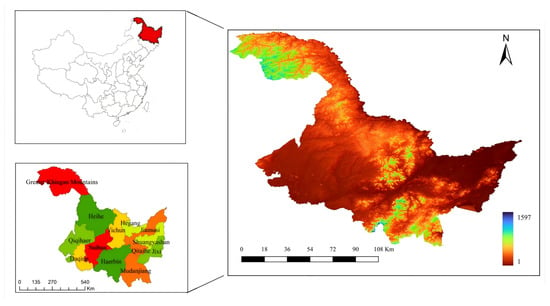
Figure 1.
Study area.
2.2. Measurement Method of Planting Industry Carbon Emissions
Carbon emissions from agricultural cropping are primarily classified into categories: (1) emissions arising from the application of chemical fertilizer, pesticides, agricultural films, diesel oil, irrigation, and plowed soil in agricultural land management; and (2) greenhouse gas emissions, such as CH4 and N2O, generated during the cultivation of crops including rice, corn, soybeans, wheat, and vegetables. This study utilizes carbon emission coefficients published by the Intergovernmental Panel on Climate Change (IPCC) of the United Nations to calculate farmland carbon emissions in Heilongjiang Province. The formula is shown in Equation (1):
where C is the total planting industry’s carbon emission, Ci is the carbon released by the i th carbon source, Ti is the input amount of the i th carbon source, and εi is the carbon emission coefficient for the i th carbon source.
The carbon sources and their corresponding emission coefficients for the planting industry are presented in Table 1.

Table 1.
Emission coefficients and different carbon sources.
Carbon emission intensity primarily reflects the relationship between economic activities and carbon emissions during agricultural production. It is measured as carbon emissions per unit of agricultural gross output value and functions as an indicator of the carbon efficiency of agricultural production and its environmental impact. The formula is shown in Equation (2):
where AEI represents the planting industry carbon emission intensity, E denotes the planting industry carbon emissions, and AGDP stands for the gross output value of the planting industry.
2.3. Decoupling Model
The ratio of the economic growth rate to the variation in carbon emissions indicates the responsiveness of carbon emission fluctuations to economic growth. There are eight decoupling states, each representing a different relationship between agricultural economic development and environmental pressure. On the basis of the decoupling elasticity coefficient, these states are categorized into three types: coupling, decoupling, and negative decoupling (as shown in Figure 2). The formula for agricultural cropping carbon emission intensity is shown in Equation (3):
where e is the elasticity value. The elasticity is calculated as the ratio of the percentage change in environmental pressure (∆C⁄C) to the percentage change in economic growth (∆GDP⁄GDP) over the period from t to t + 1. Figure 2 illustrates the degrees of coupling and decoupling of agricultural cropping carbon emissions (ΔC) from agricultural output value (ΔGDP).
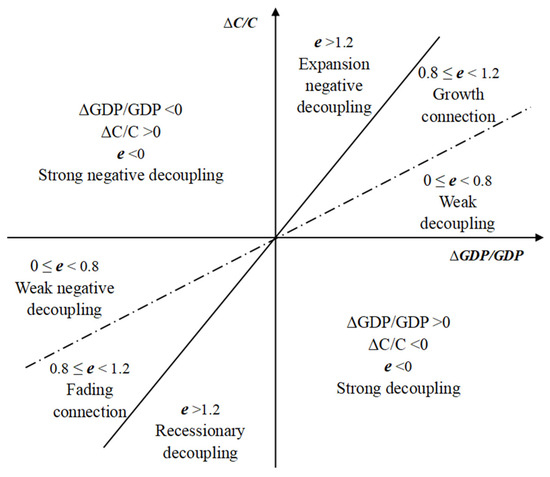
Figure 2.
Tapio decoupling state criteria. Note: 1. Expansion negative decoupling: With the growth of the agricultural economy, environmental pressure has increased significantly; 2. Strong negative decoupling: Agricultural economies are declining, and environmental pressures are increasing; 3. Weak negative decoupling: Agricultural economic decline, environmental pressure slowly receding; 4. Weak decoupling: The agricultural economy is growing, and the environmental pressure is growing slowly; 5. Strong decoupling: The agricultural economy grows and the environmental pressure is reduced; 6. Recessionary decoupling: The agricultural economy is in decline, and the environmental pressure is greatly diminished; 7. Growth connection: Agricultural economic growth, environmental pressure is increasing at a moderate speed; 8. Fading connection: The agricultural economy is in decline, and environmental pressure is significantly reduced.
2.4. Influencing Factor Decomposition Model of Carbon Emission
The Kaya identity aims to analyze the impact of human activity on the environment. Analyzing the interactions and trends among carbon emissions, energy consumption, population, and economic development provides a more accurate assessment of the combined effects of various factors on carbon emissions, thereby facilitating the formulation of more effective emission reduction strategies. Based on the specific characteristics of carbon emissions from the planting industry in Heilongjiang Province, the identity is appropriately modified, as shown in Equations (4)–(8):
where CT is the planting industry’s carbon emissions. PGDP is the planting industry output value, AGDP is the total output value of agriculture, POP is the total number of people engaged in agriculture, forestry, animal husbandry and fisher. EI is the planting industry production efficiency, CI is the planting industry production structure, SI is the planting industry output level, and AI is a factor of agricultural population size. Based on the above, Equation (4) can be simplified as:
Building on Equation (9), the change in carbon emissions from the agricultural cropping in Heilongjiang Province, denoted as ΔC from the base period C0 to the reporting period Ct, can be decomposed into factors of production efficiency, industrial structure, economic level, and agricultural population size. This decomposition is expressed in Equation (10) as follows:
By taking the logarithm of both sides of Equation (10) and applying the additive decomposition method, the formula is shown in Equations (11)–(14):
where C0 is the base period, and Ct is the target period. ΔEI, ΔCI, ΔSI, and ΔAI are the contribution values of planting industry production efficiency, planting industry production structure, planting industry output level, and agricultural labor force scale, respectively, to the change in farmland carbon emissions from the base period to period t. ΔC is the total effect of agricultural cropping carbon emissions caused by all influencing factors.
2.5. Carbon Emission Prediction Model of Planting Industry
The BP neural network prediction approach has gradually garnered widespread attention. The BP neural network (back-propagation network, BP) is an artificial neural network model that employs error back-propagation. The prediction results are derived via numerous iterations of forward propagation and error back-propagation. This research uses the BP neural network to forecast carbon emissions from the planting industry in Heilongjiang Province for the period 2023 to 2030. The detailed methods are as follows:
- (1)
- The training and result computation of the BP neural network prediction model are conducted via MATLAB R2020b software. The weight calculation algorithm is implemented using the trainlm function, which corresponds to the Levenberg-Marquardt algorithm. The network parameters are set as follows: 3 input layers and 1 output layer; 70% of the data is used as the training set, 15% as the validation set, and 15% as the test set, and the number of hidden layer nodes is set to 10.
- (2)
- The detailed workflow for network training is as follows:

- (3)
- Evaluation of BP neural network prediction outcomes. The formula for the BP neural network prediction model is presented in (15), which may be utilized to assess the magnitude of the inaccuracy. If the error is within 5%, it satisfies the criteria, signifying its suitability for prediction.where E is the error rate, Xi is the predicted value, and X0 is the actual value.
2.6. Data Sources
The primary data used in this study are sourced from the Heilongjiang Statistical Yearbook (2003–2022), the China Statistical Yearbook, and the National Bureau of Statistics of China’s National Data website. Statistical analysis data were obtained by Excel 2021. In the process of calculating carbon emissions from agricultural land, the following criteria were applied: chemical fertilizers were measured on the basis of their pure nutrient content; pesticides, agricultural films, and diesel were measured on the basis of their actual application amounts in the respective year; irrigation was measured on the basis of the effective irrigated area; and tillage was measured on the basis of the actual sown area of crops. For the calculation of carbon emissions from farmland soils, the actual cultivated areas of rice, corn, soybeans, wheat, and vegetables were used as the basis.
3. Results
3.1. Analysis of the Structure and Temporal Trends of Carbon Emissions in the Planting Industry
3.1.1. Analysis of the Structure and Temporal Trends of Carbon Emissions from Agricultural Land Use
As shown in Figure 3, from 2003 to 2022, carbon emissions from chemical fertilizers, pesticides, agricultural films, and fuel first increased before subsequently declining, whereas carbon emissions from tillage and irrigation demonstrated a continuous growing trend. All chemical fertilizers, pesticides, and agricultural films peaked prior to 2015, with carbon emissions of 2.1946 million tons, 431,100 tons, and 442,300 tons, respectively. In 2018, diesel emissions peaked at 873,600 tons of carbon. The percentage of chemical fertilizers diminished from 24.72% to 20.21%, pesticides from 5.93% to 2.89%, agricultural films from 5.91% to 3.22%, diesel from 11.58% to 8.32%, tillage from 0.56% to 0.42%, while irrigation escalated from 0.89% to 1.35%. The findings reveal that the primary sources of carbon emissions in agricultural land use are chemical fertilizers, pesticides, agricultural films, and diesel, whereas tillage and irrigation contribute comparatively minor shares.
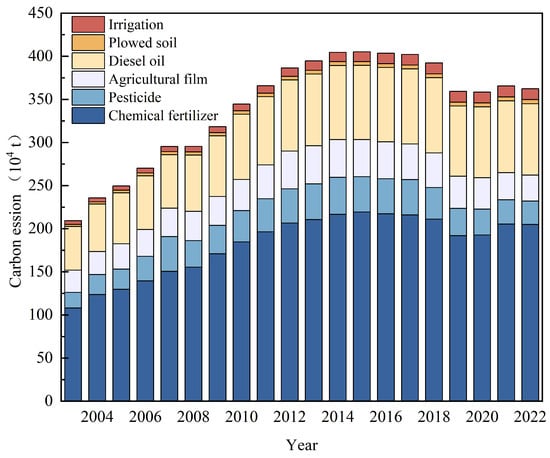
Figure 3.
Change trend of carbon emissions from various carbon sources of agricultural land utilization in Heilongjiang Province from 2003 to 2022.
3.1.2. Analysis of the Structure and Temporal Trends of Carbon Emissions from Farmland Soil
As shown in Figure 4, between 2003 and 2022, the modification of Heilongjiang Province’s cultivation framework led to a significant escalation in carbon emissions from maize, which surged from 418,400 tons to 1,227,500 tons, with its share growing from 8.68% to 13.78%. Correspondingly, carbon emissions from rice escalated markedly from 1,483,000 tons to 4,125,900 tons, with its share augmenting from 33.95% to 46.65%. In contrast, while soybean emissions rose considerably from 202,900 tons to 308,600 tons, their percentage declined significantly from 4.78% to 1.61%. Simultaneously, carbon emissions from wheat and vegetables showed a consistent annual reduction, with their shares decreasing from 0.82% to 0.04% and from 3.13% to 0.53%, respectively. Collectively, these findings suggest that rice and maize are the predominant sources of carbon emissions in the province’s agricultural soil, whereas soybean, wheat, and vegetables contribute comparatively minor proportions.
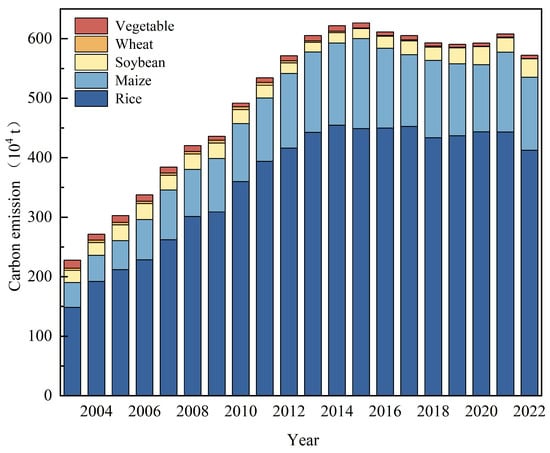
Figure 4.
Change trend of carbon emissions from various carbon sources of farmland soil in Heilongjiang Province from 2003 to 2022.
As shown in Figure 5, carbon emissions from farming soil in all cities have risen annually. Harbin, Qiqihar, Jiamusi, and Suihua are the four cities with the greatest emissions in Heilongjiang Province. Between 2003 and 2022, their maximum emissions were recorded at 991,300 tons (Harbin, 2014), 690,600 tons (Qiqihar, 2017), 1,322,100 tons (Jiamusi, 2019), and 854,100 tons (Suihua, 2017), respectively. Furthermore, rice constitutes the primary source of high carbon emissions in all four cities, followed by maize. The extensive rice growing in Harbin and Jiamusi has resulted in persistently elevated emissions from 2003 to 2022. Conversely, Daxing’anling, Heihe, and Mudanjiang demonstrate comparatively minimal farming soil carbon emissions within the province.
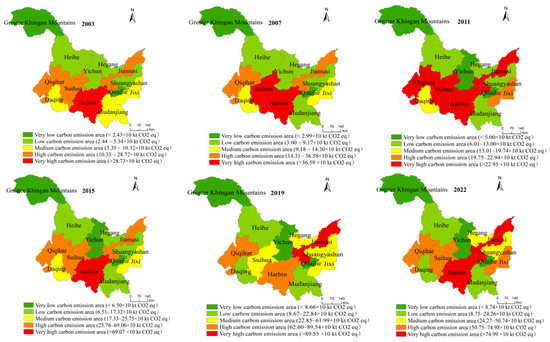
Figure 5.
Change trend of farmland soil carbon emission in Heilongjiang Province.
3.1.3. Analysis of Temporal Characteristics of Total Carbon Emissions in the Planting Industry
As shown in Figure 6, from 2003 to 2022, the percentage of carbon emissions attributable to agricultural land use and farmland soils exhibited minimal fluctuation. On an annual basis, carbon emissions from agricultural land use demonstrated a marginal rise, maintaining an overall constant trend. In contrast, carbon emissions from farmland soils initially increased and subsequently fell, rising from 2.2776 million tons in 2003 to 6.2646 million tons in 2015, reaching a peak in 2015 before dropping thereafter. Consequently, the total carbon emissions from the planting industry in Heilongjiang Province also followed an initial increase, followed by a decrease. Total carbon emissions from the planting sector in Heilongjiang Province increased from 4.7310 million tons in 2003 to 10.3136 million tons in 2015, peaking in 2015 before decreasing to 9.3443 million tons in 2022. Nonetheless, the emissions in 2022 were substantially elevated compared to those in 2003 by 4.9733 million tons, signifying a formidable challenge for emission reduction efforts. Following a peak in 2015, emissions had a downward trajectory from 2016 to 2019, subsequently experiencing a 1.23% resurgence in 2020. The inertia of agricultural production and technological developments has stabilized the town area, causing a steady deceleration in the rate of change of carbon emissions. In contrast to total carbon emissions, carbon emission intensity more accurately represents the quality of regional carbon emissions. Between 2003 and 2022, the province’s carbon emission intensity diminished from 0.87 to 0.22, reflecting a progressive decrease in carbon emissions concurrent with a consistent rise in the gross output value of agriculture, forestry, animal husbandry, and fishery. This led to a sustained reduction in agricultural carbon emission intensity.
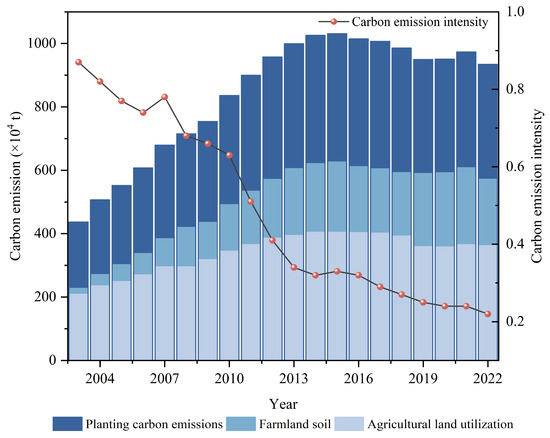
Figure 6.
Change trend of carbon emission and carbon emissions intensity of the planting industry in Heilongjiang Province from 2003 to 2022.
3.2. Decoupling Analysis of Carbon Emissions and Economic Growth in the Planting Industry
The Tapio elasticity indices for carbon emissions and economic growth in the planting industry of Heilongjiang Province are presented in the table. Combined with the trends of both variables, the decoupling states of Heilongjiang Province from 2004 to 2022 are illustrated in Figure 7.
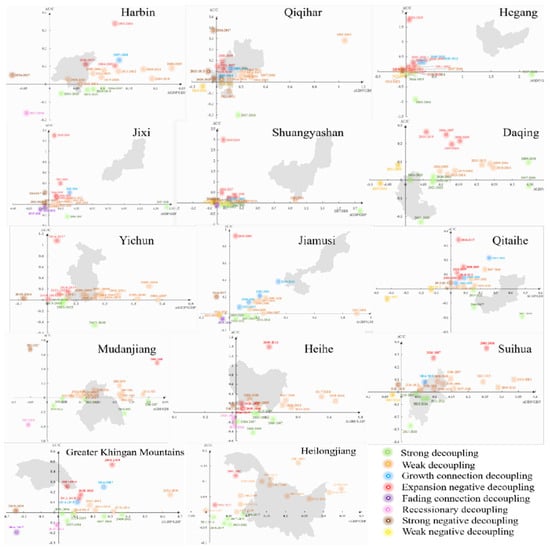
Figure 7.
Dynamic change of the decoupling state of carbon emissions and GDP in Heilongjiang Province from 2003 to 2022. Note: 1. Strong decoupling: ΔGDP/GDP > 0, ΔC/C < 0, e < 0; 2. Weak decoupling: 0 ≤ e < 0.8; 3. Growth connection: 0.8 ≤ e < 1.2; 4. Expansion negative decoupling: e > 1.2; 5. Fading connection: 0.8 ≤ e < 1.2; 6. Recessionary decoupling: e > 1.2; 7. Strong negative decoupling: ΔGDP/GDP < 0, ΔC/C > 0, e < 0; 8. Weak negative decoupling: 0 ≤ e < 0.8.
Overall, from 2003 to 2022, the decoupling between carbon emissions and GDP in Heilongjiang Province exhibited a weak decoupling state, indicating that the growth rate of GDP exceeded the growth rate of carbon emissions, reflecting a favorable decoupling performance. Subsequent to the ratification of the Paris Agreement at the 2015 Paris Climate Conference, China published the White Paper on China’s Policies and Actions on Climate Change and annual reports. In accordance with national policy, our province has vigorously executed the “Zero Growth Action Plan for Pesticides and Chemical Fertilizers.” From 2015 to 2016, Harbin, Hegang, Mudanjiang, and the Greater Khingan Mountains achieved strong decoupling, while Qiqihar, Jixi, Daqing, and Suihua exhibited weak decoupling. In contrast, Yichun and Heihe showed expansive negative decoupling, demonstrating that China is earnestly fulfilling its commitments under the Paris Agreement. Overall, the correlation between carbon emissions and economic growth in Heilongjiang Province’s planting industry has a trend to transition from weak decoupling to strong decoupling, which aligns closely with the temporal changes in carbon emissions from the planting industry. The output value of the planting industry has steadily increased, whereas carbon emissions from farmland soils initially rose gradually before experiencing a prolonged decrease. This has led to an improvement in the decoupling state from unfavorable to favorable. From 2004 to 2015, the overall decoupling state was weak, indicating that during this period, the gross output value of the planting industry and carbon emissions were positively correlated, both showing an upward trend, with the growth rate of the gross output value exceeding that of carbon emissions. However, in 2007, an expansive negative decoupling state emerged, characterized by an increase in the output value of the planting industry alongside a rapid rise in environmental pressure. From 2016 to 2022, the overall decoupling state was strong, with most decoupling elasticity values being negative. As the gross output value of the planting industry increased, carbon emissions from the sector decreased, indicating a well−established, sustainable, and coordinated development relationship between carbon emissions and economic growth. This indicates that the negative environmental impact of agricultural development is diminishing, reflecting the efforts made by Heilongjiang Province towards emission reductions in the planting industry.
3.3. Analysis of Factors Influencing Carbon Emissions in the Planting Industry
The contribution rates of production efficiency, industrial structure, economic level, and agricultural population to carbon emissions in the planting industry of Heilongjiang Province were analyzed via the LMDI model. The decomposition results of the factors influencing carbon emissions in the planting industry of Heilongjiang Province from 2003 to 2022 are as follows:
As shown in Figure 8, the significant contributions of various factors to carbon emissions in the planting industry of Heilongjiang Province are evident. From 2003 to 2022, the principal determinants of carbon emissions in the planting industry of Heilongjiang Province were economic level and industrial structure. The economic level significantly influenced carbon emissions, resulting in a rise of 18.8350 million tons, with a contribution rate of 379.56%. With economic development, carbon emissions concurrently escalated. Additionally, the industrial structure contributed 1.3838 million tons to carbon emissions, significantly impacting emission fluctuations and representing 27.89% of the total increase. Production efficiency and the agricultural population negatively contribute to carbon emissions in the planting industry, effectively curbing the increase in carbon emissions. Their contributions to carbon reduction totaled 12.1809 million tons and 3.0755 million tons, respectively. Production efficiency was the most significant factor promoting carbon emission reduction in the planting industry of Heilongjiang Province, with a contribution rate of −245.47% to carbon emissions from 2003 to 2022.
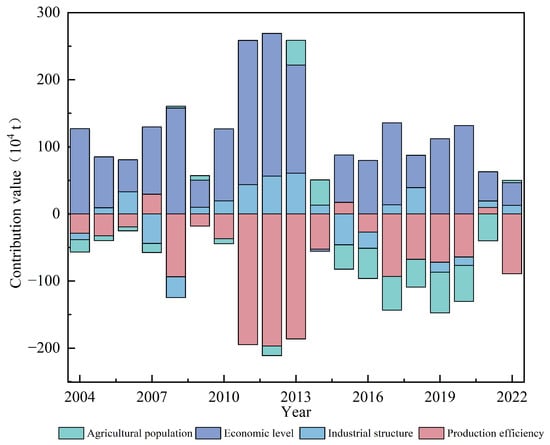
Figure 8.
Inter-annual map of carbon emission effects of the planting industry in Heilongjiang Province.
3.4. Forecast of Carbon Emission Trends
A BP neural network prediction model was constructed with carbon emission data from the planting industry in Heilongjiang Province and its urban farmland soils, covering the period from 2006 to 2022 as the primary dataset. The model was used to project carbon emissions from Heilongjiang Province’s planting industry for the period 2023 to 2030, as illustrated in Figure 9, and to predict carbon emissions from farmland soils in Heilongjiang Province and its cities. The predictive analysis indicates that carbon emissions in the planting industry in Heilongjiang Province have oscillated, with a general decline noted since 2013. In 2023, carbon emissions will decrease to 8.8435 million tons. Subsequently, following 2023, emissions escalated, culminating in a peak at 13.2680 million tons in 2029. This indicates that the measures implemented by Heilongjiang Province to control carbon emissions in the planting industry have been effective, but further efforts are needed to strengthen these measures after 2023. As illustrated in Figure 10, from 2023 to 2030, carbon emissions from farmland soils in Qiqihar city exhibit a variable increasing tendency. With the exception of Qiqihar, which did not attain its peak during the 2023 to 2030 period, the remaining 12 cities all achieved their peak emissions within this time frame.
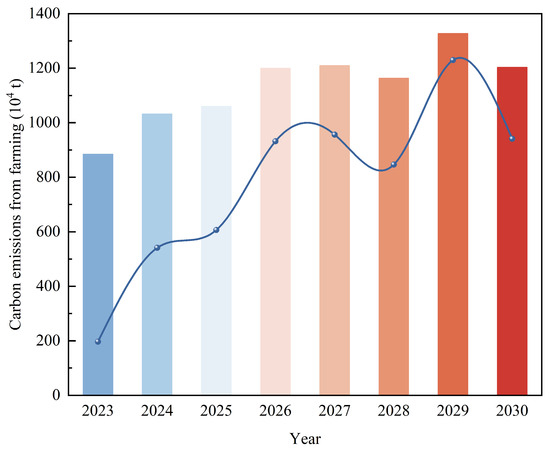
Figure 9.
Carbon emission prediction of the planting industry in Heilongjiang Province.
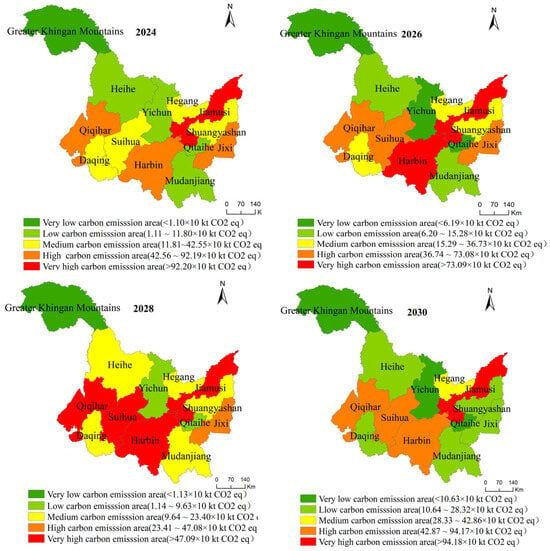
Figure 10.
Prediction of farmland soil carbon emissions in Heilongjiang Province and its cities.
To validate the effectiveness of the prediction model, carbon emission data from 2006 to 2022 were utilized for forecasting, and the errors between the predicted values and actual values were analyzed to assess the rationality and adequacy of the model. As shown in Figure 11, the BP neural network exhibits a strong fit, indicating that the model can provide relatively accurate predictions.
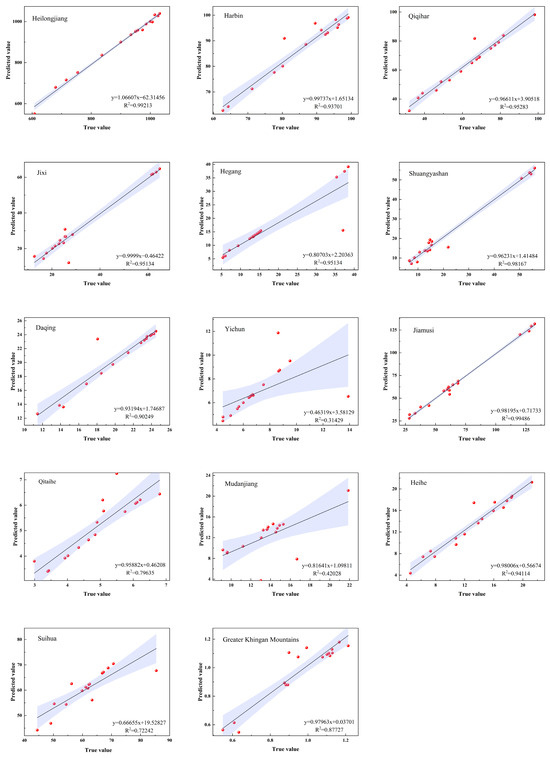
Figure 11.
The fitting effect between actual and predicted values. Note: 1. The closer the red dot distribution is to the fitting line, the closer the predicted value is to the real value, and the better the prediction effect of the model; 2. The shaded area represents the confidence interval of the predicted value. The confidence interval reflects the range in which the true value may occur at a given level of confidence. The width of the confidence interval indicates the reliability of the prediction.
4. Discussion
4.1. Characteristics of Carbon Emissions in the Planting Industry of Heilongjiang Province
This study assesses carbon emissions from crop production in Heilongjiang Province by examining two aspects: agricultural land utilization (including rice, wheat, maize, soybean, and vegetable agriculture) and soil processes (related to the application of agricultural inputs). The research quantifies regional crop production emissions and analyzes their temporal dynamics and spatial-temporal variation patterns. In contrast to prior studies by Dong et al. [33] and Nurse et al. [34], this approach provides a more comprehensive and robust framework for carbon emission accounting. Findings reveal that crop production carbon emissions in Heilongjiang Province exhibit an inverted U-shaped trajectory, reaching a peak in 2015, with farmland soil-related emissions constituting a substantial proportion of the total. Wu et al. [35] calculated China’s carbon emissions from agriculture between 2000 and 2020 and found that Heilongjiang’s emissions plateaued in 2015, which was a little later than the year when the carbon peak was mentioned. Differences in how carbon sources are defined can be the cause of this disparity: Wu’s methodology included soil management, rice cultivation, straw combustion, and agricultural inputs; however, differences in carbon emission factors between source categories inevitably lead to differences in estimated emission volumes and, consequently, the reported peak’s timing.
In the context of global climate change mitigation, regulating agricultural carbon emissions has become a vital necessity for sustainable development. Rice, a principal worldwide food crop, considerably contributes to CH4 and N2O emissions during its production cycle. Heilongjiang Province, a significant rice-producing area in China, serves as a distinguished center for rice growing, illustrating both local agricultural production traits and the overarching issues associated with the global agricultural green shift. Sun et al. [36] have demonstrated that rice systems represent a key source of global greenhouse gas emissions, a conclusion that aligns closely with this study’s findings: rice is identified as the dominant carbon emitter within Heilongjiang’s farmland soil system, and municipalities with intensive rice cultivation exhibit disproportionately higher emission levels.
The temporal study of crop production emissions provides a detailed comprehension of emission intensity, facilitating the recognition of phased alterations in emission patterns across designated intervals. This enables the evaluation of the efficacy of enacted mitigation programs and the advancement towards low-carbon, sustainable development goals. The noted reduction in crop production emissions in Heilongjiang since 2015 indicates the province’s proactive adoption of policies targeting zero growth in chemical fertilizer and pesticide usage, coupled with strategic modifications to the planting structure to enhance sustainability.
4.2. Analysis of Carbon Emissions Influencing Factors in the Planting Industry in Heilongjiang Province
This study employs the Logarithmic Mean Divisia Index (LMID) model to conduct an influencing factor analysis of carbon emissions in Heilongjiang Province’s planting industry from four dimensions: industrial structure, production efficiency, economic development level, and agricultural population. Analytical results indicate that economic development level and production efficiency constitute the primary factors affecting carbon emissions in the planting sector, with the two factors demonstrating contrasting effects on emission levels. This finding is consistent with the research outcomes of Meng et al. [37], who analyzed the influencing factors of dynamic changes in agricultural carbon emissions in Heilongjiang Province. The negative contributions of production efficiency and agricultural population have partially offset the positive impacts of economic development level and industrial structure; however, the significant growth in economic development remains the dominant driver of rising carbon emissions. Typically, advancements in economic development correlate with increased agricultural mechanization, higher inputs of chemical fertilizers and pesticides, and improved irrigation infrastructure—factors that directly or indirectly contribute to elevated carbon emissions. Conversely, production efficiency emerges as the most critical factor promoting carbon emission reduction in Heilongjiang’s planting industry. Improvements in production efficiency have, to a certain extent, mitigated the emission increases caused by changes in economic development level and industrial structure.
In the context of rapid global economic and technological progress, China should integrate the regional characteristics of Heilongjiang Province while promoting intelligent agriculture. Specific strategies include adopting precision agricultural technologies to enhance the utilization efficiency of chemical fertilizers and water resources, implementing improved irrigation methods, promoting ecological planting models, and applying precision organic fertilizer management [38,39]—all of which aim to boost production efficiency and reduce greenhouse gas emissions. Additionally, parallel efforts should focus on deploying green and low-carbon technologies during agricultural economic development to achieve a balance between economic growth and environmental protection. Potential pathways for enhancing production efficiency encompass the adoption of high-efficiency agricultural technologies, optimization of planting patterns, and minimization of resource waste through systematic management practices.
4.3. Analysis of Decoupling State of Planting Industry in Heilongjiang Province
Analysis utilizing the Tapio decoupling model suggests that reaching a carbon peak amid agricultural economic development necessitates a reduction in carbon emission intensity that exceeds the rate of economic growth. The decoupling status exhibited instability from 2003 to 2022. This investigation reveals that the overall decoupling status progressed from weak to high decoupling, consistent with the findings of Chu et al. [24]. Rationally adjusting carbon emission intensity is essential for mitigating carbon emissions and attaining the 2030 carbon peak objective.
On one hand, ongoing advancements in agricultural science and technology, such as the implementation of precision agriculture and innovative integrated planting-breeding models, have significantly diminished carbon emissions in the cultivation sector. Conversely, enhanced governmental assistance, encompassing subsidy initiatives for diminishing chemical fertilizer and pesticide utilization, as well as incentives for recycling agricultural waste, has further propelled low-carbon advancement in agriculture. Agricultural economic growth has been accompanied by technological advancements, including the widespread adoption of efficient large-scale machinery and increased investment in R&D projects that have resulted in new fertilizer innovations, both of which have diminished energy consumption and carbon emissions.
Nonetheless, forthcoming emission reduction initiatives that depend exclusively on strategies like minimizing chemical fertilizers, pesticides, agricultural films, tillage, and irrigation in cultivation have nearly reached their efficacy limits. Consequently, the formulation of novel emission reduction programs is essential.
4.4. Countermeasures for Emission Reduction and Carbon Sequestration in the Planting Industry of Heilongjiang Province
He [31] utilized several models to forecast carbon emissions from animal husbandry, revealing that the BP neural network model has superior fitting efficacy and enhanced predictive accuracy. This study employs a BP neural network model to analyze the projected trajectory of carbon emissions in the planting industry in Heilongjiang Province. A time series study indicates that carbon emissions from the planting industry in Heilongjiang Province are expected to rise after 2023, peaking in 2029. From the perspective of agricultural production methods, the increase in mechanization levels after 2023 has led to the widespread use of agricultural machinery, resulting in higher diesel consumption and a subsequent rise in carbon emissions. From the perspective of economic and demographic factors, population growth has driven a more significant demand for agricultural products, further contributing to the increase in carbon emissions. Moreover, economic progress has propelled the increase in agricultural production, resulting in an increase in carbon emissions. The application of nitrogen fertilizers contributes to higher emissions of N2O. Studies have shown that appropriately reducing the application of nitrogen fertilizers can effectively lower greenhouse gas emissions [40]. Furthermore, tillage practices impact the physical and chemical qualities of soil, thereby affecting its chemical and biological characteristics and resulting in enhanced greenhouse gas emissions [41]. From the standpoint of farmland carbon emissions, the carbon emissions from farmland soils in Heilongjiang Province tend to vary. Except for Qiqihar city, the carbon emissions from farmland soils in the other 12 cities are projected to peak between 2023 and 2030. This suggests that Qiqihar City must enhance governmental intervention, advance sustainable agriculture practices, and execute tailored emission reduction strategies reflective of its distinct attributes to attain its carbon emission peak promptly. The slight decline in farmland soil carbon emissions after 2022 suggests that there have been changes in the structure of the planting industry.
4.5. Suggestions
In recent years, the principal strategies for emission reduction in Heilongjiang Province’s agricultural sector have encompassed minimizing nitrogen fertilizer usage, altering the cropping structure to reduce rice production, and revising tillage practices. Considering the regional attributes of Heilongjiang Province, the subsequent strategies may be implemented for future low-carbon and green development:
First, from the standpoint of planting structure, it is essential to suitably modify the cultivation of high-carbon rice, broaden the intercropping model of drought-resistant crops with shelterbelts, and cultivate low-carbon crops characteristic of cold regions, such as high-oil soybeans. The continuation of soil testing and formula-based fertilization, together with the replacement of chemical fertilizers with organic alternatives, is essential for fertilization practices. Moreover, the implementation of drone-assisted pesticide application technology should be augmented to attain accurate fertilization.
Second, from a resource use standpoint, efforts should concentrate on developing microbial strains that can decompose crop straw at low temperatures, facilitating straw decomposition during the frigid winters of Heilongjiang. This would elevate the rate of straw reincorporation into cropland and augment soil organic matter content. Furthermore, employing straw for heating can diminish carbon emissions while achieving resource recycling. It is imperative to establish a closed-loop system of “planting-processing-waste resource utilization” to optimize material circulation.
Third, from the perspective of stakeholder participation, subsidy policies ought to be enacted to promote the return of straw to agricultural land and the utilization of new-energy farming machines. These efforts seek to attain a trifecta of equilibrium among food security, ecological preservation, and low-carbon advancement, thus enabling the achievement of the carbon peak objective by 2030.
5. Conclusions
The province’s planting industry carbon emissions “inverted U-shaped” from 2003 to 2022, peaking at 10.32 million tons in 2015. Fertilizer application was the main driver of agricultural carbon emissions, and rice was the main crop for soil emissions, but maize plantings increased and exceeded rice. Growth and carbon emissions follow a three-stage evolution of “weak decoupling—expansion negative decoupling—strong decoupling,” with economic scale and industrial structure favoring emission growth, production efficiency improving, and agricultural population reduction reducing emissions. The BP model forecasts that carbon emissions will climb to 10.32 million tons in 2024 and 13.27 million tons in 2029, with Harbin and Qiqihar as high-emission locations and Qitaihe and the Greater Khingan Mountains as low-carbon.
Author Contributions
Conceptualization, M.Z. and Z.Y.; methodology, Z.Y., Y.Z. (Yuxian Zhang), and M.Z.; validation, Y.Z. (Yuxian Zhang) and Y.F.; formal analysis, Z.Y. and M.S.; investigation, Y.Z. (Yingce Zhan), C.W. and H.G.; data curation, Z.Y. and X.L.; writing—original draft preparation, Z.Y.; writing—review and editing, M.Z.; visualization, X.L.; supervision, M.Z., W.Z., Y.G. and Y.F.; project administration, Z.Y.; funding acquisition, M.Z. All authors have read and agreed to the published version of the manuscript.
Funding
This paper was funded by the double first-class of Heilongjiang Province discipline collaborative innovation achievement construction project: Green and low-carbon projects for grain crops (No. LJGXCG2022-107), Scientific and Technological Innovation projects(No. 2023ZD0403106), Natural Science Foundation Project of Heilongjiang Provincial (No. LH2022D019), and Postdoctoral Scientific Research Startup Fund Project of Heilongjiang Provincial (No. LBH-Q21162).
Institutional Review Board Statement
Not applicable.
Data Availability Statement
The datasets generated during and/or analyses during the current study are not publicly available, but are available from the corresponding author on reasonable request.
Conflicts of Interest
Author Wei Zhou was employed by the company Daqing Qilong Agricultural Science and Technology Limited Company. The remaining authors declare that the research was conducted in the absence of any commercial or financial relationships that could be construed as a potential conflict of interest.
References
- Tang, Z.; Zhang, X.; Chen, R.; Ge, C.; Tang, J.; Du, Y.; Jiang, P.; Fang, X.; Zheng, H.; Zhang, C.A. Comprehensive Assessment of Rice Straw Returning in China Based on Life Cycle Assessment Method: Implications on Soil, Crops, and Environment. Agriculture 2024, 14, 972. [Google Scholar] [CrossRef]
- Wang, G.F.; Zhao, M.Q.; Zhao, B.H.; Liu, X.L.; Wang, Y. Reshaping Agriculture Eco-efficiency in China: From Greenhouse Gas Perspective. Ecol. Indic. 2025, 127, 113268. [Google Scholar] [CrossRef]
- Zhang, X.D.; Zhang, J.; Yang, C.B. Spatio-Temporal Evolution of Agricultural Carbon Emissions in China, 2000–2020. Sustainability 2023, 15, 3347. [Google Scholar] [CrossRef]
- Steponavičienė, V.; Žiūraitis, G.; Rudinskienė, A.; Jackevičienė, K.; Bogužas, V. Long-Term Effects of Different Tillage Systems and Their Impact on Soil Properties and Crop Yields. Agronomy 2024, 14, 870. [Google Scholar] [CrossRef]
- Tao, A.X.; Liu, C.; Wang, Z.H. Research on the Implementation Path of Agricultural Carbon Reduction in Heilongjiang Province. E3S Web Conf. 2023, 406, 04036. [Google Scholar] [CrossRef]
- Kong, D.L.; Jiang, P.K. Approaches and policy recommendations for reducing emissions and increasing carbon sinks in crop industry under the background of carbon peak and carbon neutrality. J. Zhejiang AF Univ. 2023, 40, 1357–1365. [Google Scholar]
- Li, X.; Chen, B.Z.; Liu, H.J.; Xu, M.Q.; Yang, H.J. Characteristics of agricultural carbon emissions in arid zones, drivers and decoupling effects: Evidence from Xinjiang, China. Energy 2025, 136373. [Google Scholar] [CrossRef]
- Cao, Y.L.; Ni, X.; Gong, H.Y. Influencing Factors and Decoupling Effects of Agricultural Carbon Emissions in the Yangtze River Economic Belt. Environ. Sci. 2025, 46, 1535–1547. [Google Scholar]
- Liu, X.; Ye, Y.; Ge, D.; Wang, Z.; Liu, B. Study on the evolution and trends of agricultural carbon emission intensity and agricultural economic development levels-evidence from Jiangxi Province. Sustainability 2022, 14, 14265. [Google Scholar] [CrossRef]
- Cui, H.; Wang, B.C.; Zhou, M.S. Spatiotemporal evolution and driving factors of China’s agricultural carbon emissions. Chin. J. Eco-Agric. 2024, 32, 1097–1108. [Google Scholar]
- Qi, Y.W.; Liu, H.L.; Zhao, J.B.; Zhang, S.Z.; Zhang, X.J.; Zhang, W.L.; Wang, Y.K.; Xu, J.J.; Li, J.; Ding, Y.L. Trends and driving forces of agricultural carbon emissions: A case study of Anhui, China. PLoS ONE 2024, 19, e0292523. [Google Scholar] [CrossRef]
- Wang, S.F.; Gao, G.L.; Li, W.; Liu, S.M. Carbon emissions from agricultural and animal husbandry in Shanxi Province: Temporal and regional aspects, and trend forecast. J. Agro-Environ. Sci. 2023, 42, 1882–1892. [Google Scholar]
- Zhang, Y.; Lv, T. Decoupling Relationship between Cultivated Land Use Intensity and Carbon Emissions: A Case Study of 25 Cities in the Middle Reaches of the Yellow River Basin. China Land Sci. 2024, 38, 105–106. [Google Scholar] [CrossRef]
- Sun, J.X.; Sun, S.K.; Yin, Y.L.; Wang, Y.B.; Zhao, J.F.; Tang, Y.H.; Wu, P.T. Decoupling trend and drivers between grain water-carbon footprint and economy-ecology development in China. Agric. Syst. 2024, 217, 103904. [Google Scholar] [CrossRef]
- Chen, K.J.; Wang, Y.G.; Liu, H.B.; Zhang, S.Q.; Jia, J. Spatio-temporal characteristics, decoupling effect and its driving factors of carbon emissions from planting industry in Henan Province. Chin. J. Agrometeorol. 2024, 45, 219–231. [Google Scholar]
- Zhao, H.L.; Chen, S.Y.; Xie, L.Y. Influencing factors and prediction analysis of carbon emissions from the planting industry in Liaoning Province. Chin. J. Eco-Agric. 2024, 32, 1818–1828. [Google Scholar]
- Suo, R.X.; Wang, Q.; Zhang, F.; Zhao, Z.Y. Study on the Decoupling Effect and Drivers of Carbon Emissions from Plantations in the Yellow River Basin. Res. Environ. Sci. 2025, 28, 220–230. [Google Scholar]
- Xiong, Y.; Dan, Y.L.; Wang, B.; Xiang, Z.M.; Liu, Z.M. The situation, dynamic evolution, and prediction of carbon emissions in the planting industry of Sichuan Province. Chin. J. Eco-Agric. 2024, 32, 1136–1147. [Google Scholar]
- He, J.J.; Jiang, Y.H.; Zhan, H. Research on characteristics and effecting factors of crop farming carbon emission in Henan Province, China. Environ. Earth Sci. 2019, 252, 042027. [Google Scholar] [CrossRef]
- Chao, Z.H.; Zhu, Z.Y.; Li, Y.C. Spatial-temporal characteristics and influencing factors of farmland carbon emissions in Guangdong Province, China. Front. Environ. Sci. 2025, 12, 2296–2665X. [Google Scholar] [CrossRef]
- Hefler, Y.T.; Kissinger, M. Grape Wine Cultivation Carbon Footprint: Embracing a Life Cycle Approach across Climatic Zones. Agriculture 2023, 13, 303. [Google Scholar] [CrossRef]
- Cai, J.L.; Gu, J.Y.; Chen, M.; Xie, L.P.; He, G.F. Drivers and prediction of carbon emissions in the China’s planting industry from 2000 to 2020. Environ. Sci. Technol. 2023, 46, 159–167. [Google Scholar]
- Li, J.J.; Li, S.W.; Liu, Q.; Ding, J.L. Agricultural carbon emission efficiency evaluation and influencing factors in Zhejiang province, China. Front. Environ. Sci. 2022, 10, 05251. [Google Scholar] [CrossRef]
- Chu, X.L.; Ye, G.S.; Zheng, L.X. Calculation and Trend Prediction of Carbon Emissions from Planting Industry in Guangdong Province. Chin. Agric. Sci. Bull. 2024, 40, 81–91. [Google Scholar]
- Zhao, L.; Feng, J.S.; Don, H. Analysis of carbon footprint and reduction approach of magnesia production in China. Clean. Prod. 2022, 334, 130194. [Google Scholar] [CrossRef]
- Zhao, L.T.; Zhao, T.; Yuan, R.T. Scenario simulations for the peak of provincial household CO2 emissions in China based on the STIRPAT model. Sci. Total Environ. 2022, 809, 151098. [Google Scholar] [CrossRef]
- Zhang, J.F. Carbon Emission Prediction and Analysis in Gansu Province Based on ARIMA Model. J. Shanxi Datong Univ. 2024, 40, 31–36. [Google Scholar]
- Lu, J.J.; Chen, H. Researching Development on BP Neural Networks. Control Eng. China 2006, 13, 449–451+456. [Google Scholar]
- Hu, Y.S.; Man, Y. Energy consumption and carbon emissions forecasting for industrial processes: Status, challenges and perspectives. Renew. Sustain. Energy Rev. 2023, 182, 113405. [Google Scholar] [CrossRef]
- Wei, C.B.; Li, J.Q.; Xu, W.; Sha, Y.Y.; Qu, Y.L. Temporal and spatial dynamics of carbon emissions in animal husbandry and their influencing factors: A case study of three provinces in Northeast China. J. Clean. Prod. 2025, 508, 145418. [Google Scholar] [CrossRef]
- He, T. Estimation and Influencing Factors of Carbon Emission in Heilongjiang Animal Husbandry; Heilongjiang Bayi Agricultural University: Daqing, China, 2023. [Google Scholar]
- Li, T.C. This year, the total grain output of our province is 155.764 billion jin. The output has ranked first in China for 14 consecutive years. J. Heilongjiang Grain 2023, 2, 15. [Google Scholar]
- Dong, R.; Wu, G.Y.; Gao, Q. Spatiotemporal evolution and development potential of carbon compensating rate of planting industry in China. Resour. Environ. Yangtze Basin 2024, 33, 409–423. [Google Scholar]
- Nurse, J.; Basher, D.; Bone, A.; Bird, W. An ecological approach to promoting population mental health and well-being—A response to the challenge of climate change. Perspect. Public Health 2010, 130, 27–33. [Google Scholar] [CrossRef] [PubMed]
- Wu, H.Y.; Zhou, L.; He, Y.Q.; Liu, L.; Ma, J.S.; Meng, Y.; Zheng, X.J. Peaking process and decoupling analysis of carbon emissions of crop production in China. Chin. J. Eco-Agric. 2023, 31, 1275–1286. [Google Scholar]
- Sun, G.L.; Zhang, Z.G.; Xiong, S.W.; Guo, X.Y.; Han, Y.C.; Wang, G.P.; Feng, L.; Li, X.F.; Yang, B.F.; Xing, F.F.; et al. Mitigating greenhouse gas emissions and ammonia volatilization from cotton fields by integrating cover crops with reduced use of nitrogen fertilizer. Agric. Ecosyst. Environ. 2023, 440, 116732. [Google Scholar] [CrossRef]
- Meng, J.; Fan, T.T. Research on affecting factors decomposition of agricultural CO2 emission in Heilongjiang Province. Ecol. Econ. 2020, 36, 34–39. [Google Scholar]
- Wu, H.; Wang, D.; Zhang, D.; Rao, W.; Yuan, Q.; Shen, X.; Ma, G.; Jie, X.; Liu, S. Responses of N2O, CO2, and NH3 Emissions to Biochar and Nitrification Inhibitors Under a Delayed Nitrogen Application Regime. Agriculture 2024, 14, 1986. [Google Scholar] [CrossRef]
- Zhao, C.X.; Qiu, R.J.; Zhang, T.; Luo, Y.F.; Agathokleous, E. Effects of Alternate Wetting and Drying Irrigation on Methane and Nitrous Oxide Emissions From Rice Fields: A Meta-Analysis. Glob. Change Biol. 2024, 30, e17581. [Google Scholar] [CrossRef]
- Park, J.R.; Jang, Y.H.; Kim, E.G.; Lee, G.S.; Kim, K.M. Nitrogen Fertilization Causes Changes in Agricultural Characteristics and Gas Emissions in Rice Field. Sustainability 2023, 15, 3336. [Google Scholar] [CrossRef]
- Mühlbachová, G.; Kusá, H.; Růžek, P.; Vavera, R.; Káš, M. Soil Organic Carbon Sequestration and Distribution, Soil Biological Characteristics, and Winter Wheat Yields Under Different Tillage Practices in Long-Term Field Experiment. Agronomy 2025, 15, 947. [Google Scholar] [CrossRef]
Disclaimer/Publisher’s Note: The statements, opinions and data contained in all publications are solely those of the individual author(s) and contributor(s) and not of MDPI and/or the editor(s). MDPI and/or the editor(s) disclaim responsibility for any injury to people or property resulting from any ideas, methods, instructions or products referred to in the content. |
© 2025 by the authors. Licensee MDPI, Basel, Switzerland. This article is an open access article distributed under the terms and conditions of the Creative Commons Attribution (CC BY) license (https://creativecommons.org/licenses/by/4.0/).